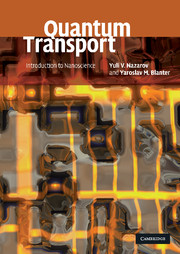Book contents
- Frontmatter
- Contents
- Preface
- Introduction
- 1 Scattering
- 2 Classical and semiclassical transport
- 3 Coulomb blockade
- 4 Randomness and interference
- 5 Qubits and quantum dots
- 6 Interaction, relaxation, and decoherence
- Appendix A Survival kit for advanced quantum mechanics
- Appendix B Survival kit for superconductivity
- Appendix C Unit conversion
- References
- Index
6 - Interaction, relaxation, and decoherence
Published online by Cambridge University Press: 05 June 2012
- Frontmatter
- Contents
- Preface
- Introduction
- 1 Scattering
- 2 Classical and semiclassical transport
- 3 Coulomb blockade
- 4 Randomness and interference
- 5 Qubits and quantum dots
- 6 Interaction, relaxation, and decoherence
- Appendix A Survival kit for advanced quantum mechanics
- Appendix B Survival kit for superconductivity
- Appendix C Unit conversion
- References
- Index
Summary
In Chapter 3, we discussed charging effects in nanostructures: the most important manifestation of electron–electron interaction in quantum transport. In this chapter, we concentrate on another aspect of interactions which we have so far mentioned very briefly. It concerns interaction with slow modes. In most cases these slow modes are electromagnetic excitations in the nanostructure and nearby circuit that form an electromagnetic environment of the nanostructure. The effect of this interaction is threefold. First, it may affect and alter transport properties of the nanostructure. Secondly, it provides energy relaxation: transporting electrons and qubits may exchange their energy with the electromagnetic environment. Thirdly, the environment provides decoherence, inducing time-dependent phase shifts to wave functions of propagating electrons and qubits, thereby destroying the quantum coherence of corresponding states.
The physics discussed in this chapter is sometimes involved and various. It requires effort to see a “common denominator” in all effects mentioned. We choose to present material starting from the ideas of dissipative quantum mechanics: a branch of quantum mechanics developed in the 1970s and 1980s. For several concrete phenomena this presentation manner deviates from that commonly accepted in the literature. Although this may be inconvenient for the reader, we did this for the sake of the “big picture,” which allows us to see links and analogies between formally different phenomena.
The structure of the chapter is as follows. Sections 6.1 and 6.2 are introductory. In Section 6.1, we discuss electromagnetic excitations in linear circuits and the way to treat them quantum-mechanically. In Section 6.2 we review general ideas of dissipative quantum mechanics, which are not specific for quantum transport: the orthogonality catastrophe, shake-up, classification of environments.
- Type
- Chapter
- Information
- Quantum TransportIntroduction to Nanoscience, pp. 457 - 561Publisher: Cambridge University PressPrint publication year: 2009



